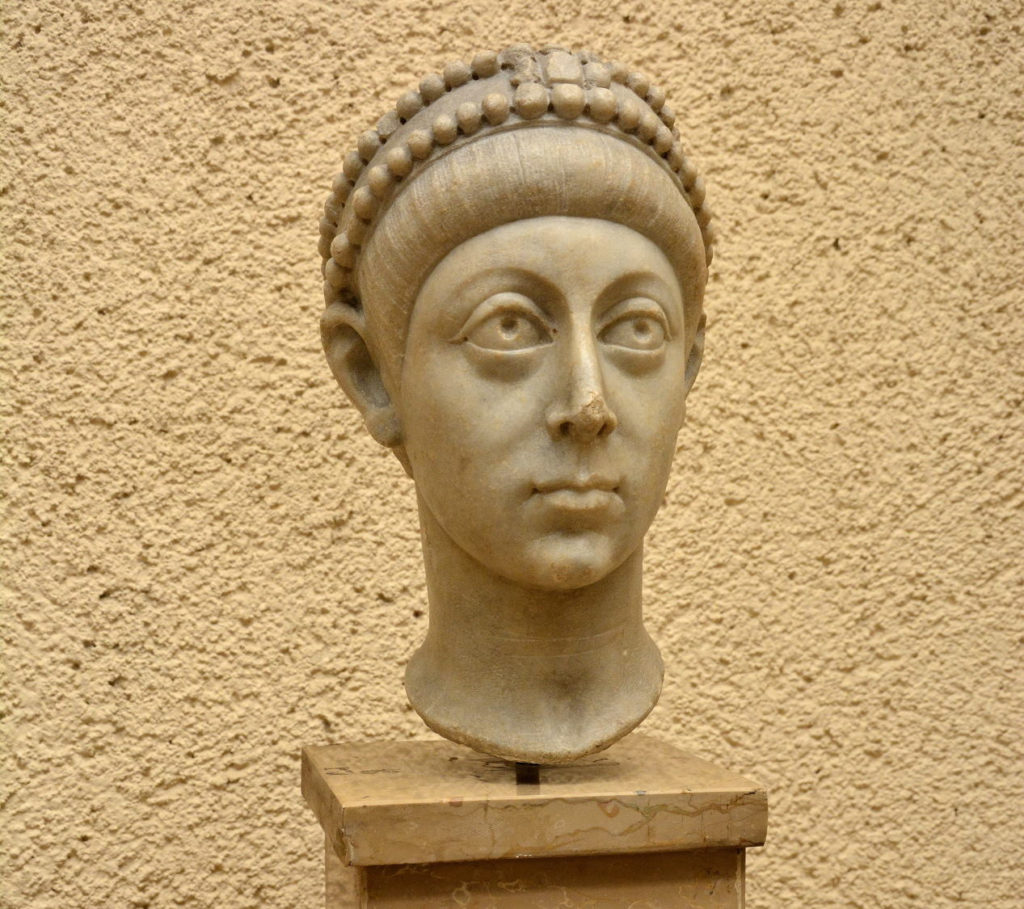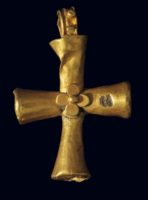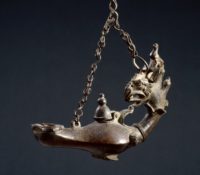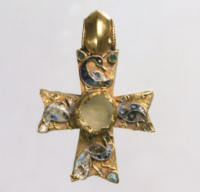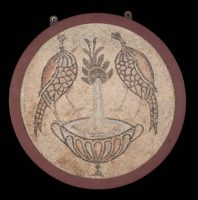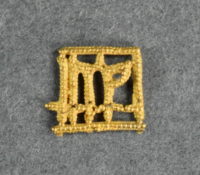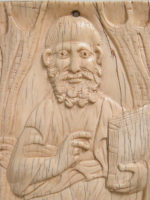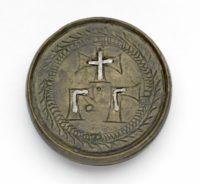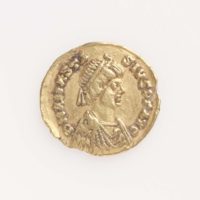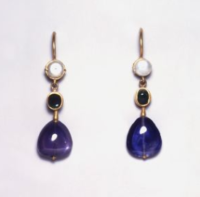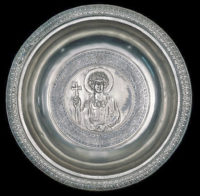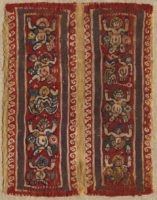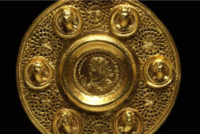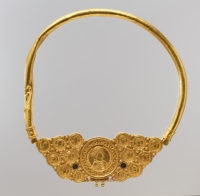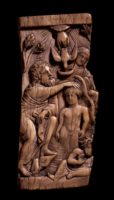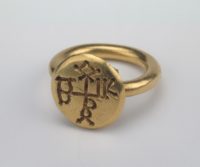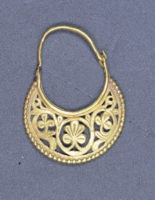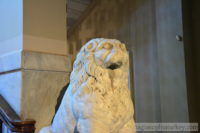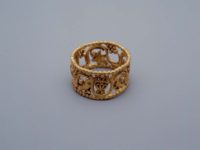Bust of Emperor Arcadius, Period: Early Byzantine circa: late 4th. century. Made in/Findspot: Constantinople (Modern Turkey; Beyazit, Istanbul) Materials: Marble. In the Istanbul Archaeological Museum collections, there are rich and very important works of art belonging to various civilizations from the regions from Africa to Balkans, from Anatolia and Mesopotamia to Arab Peninsula and Afghanistan that were in the borders of the Ottoman Empire.
Cross, with a decorative quatrefoil rosette at the juncture of the arms. Materials: gold. Period: Early Byzantine; circa: Early 7th c. The Benaki Museum of Greek Culture is housed in one of the most beautiful neoclassical-style buildings in Athens, near the National Garden and the Hellenic Parliament.
[xyz-ihs snippet="Benaki-Hotels"]Lamp for suspension; Period: Early Byzantine. circa: 4thc-5thc. Materials: Brass; the curved handle in the shape of the head and neck of a crested dragon holding an apple in its mouth, and bearing on its head a sacred monogram surmounted by a dove. Subjects:leaf, fruit, dragon and bird. Found Place: Herculaneum, Naples.
Dimensions: Length: 21 centimetresHeight: 15.7 centimetres (lamp)Width: 7.2 centimetresHeight: 41.2 centimetres (including chain)Weight: 1.126 kilograms. British Museum is closed 24, 25 and 26 December and 1 January, but is open every other day of the year. Fast facts about the British Museum: Founded: 1753, Collection size: 8 million objects, Oldest object in the collection: Stone chopping tool (nearly 2 million years old).
Gold coin of Constantine IV; Period: Early Byzantine Period; Date: 654-685; Minted in Rome. British Museum is closed 24, 25 and 26 December and 1 January, but is open every other day of the year. Fast facts about the British Museum: Founded: 1753, Collection size: 8 million objects, Oldest object in the collection: Stone chopping tool (nearly 2 million years old).
Pendant Cross with Birds and Zoe-Phos, Period: Early Byzantine, circa Late 6th Century. Materials: filigree enamel on gold. The museum is open to the public Tuesday through Sunday, 11:30 a.m.–5:30 p.m., except for federal holidays.
Mosaic, Two Peacocks Perch on a Fountain, Period: Early Byzantine, circa: A.D. 450–462. The MFA is open 7 days a week. Monday and Tuesday 10 am–5 pm, Wednesday–Friday 10 am–10 pm, Saturday and Sunday 10 am–5 pm.
Personal gold ornament; Period: Early Byzantine Period; circa: 6thC-7thC. Length: 8 millimetres, Width: 7 millimetres. British Museum is closed 24, 25 and 26 December and 1 January, but is open every other day of the year. Fast facts about the British Museum: Founded: 1753, Collection size: 8 million objects, Oldest object in the collection: Stone chopping tool (nearly 2 million years old).
Panel with St. Peter or St. Paul, Period: Early Byzantine circa: 500s, Made in Byzantine Egypt, Materials: Ivory. Dimensions: 9 1/8 x 4 1/8 x 5/16 in. (23.1 x 10.5 x 0.8 cm). On view at The Met Fifth Avenue in Gallery 300. The Metropolitan Museum of Art (New York) is one of the world’s largest and finest art museums. Its collection includes more than two million works of art spanning five thousand years of world culture, from prehistory to the present and from every part of the globe. Public Hours: 10:30 a.m.–5:30 p.m. Open seven days a week.
Copper Alloy Weight, Period: Early Byzantine, 6thc-7thc, discoidal with double-grooved convex profile; lathe-turned with rims; face engraved with double wreath enclosing cross above denominational mark, both inlaid with silver. British Museum is closed 24, 25 and 26 December and 1 January, but is open every other day of the year.
Tremissis of Theodoric in the name of Anastasius I, Period: Early Byzantine; circa: 491–518 A.D. Minted: Kingdom of the Ostrogoths, Ravenna. Materials: Gold. The Museum of Fine Arts, Boston is open 7 days a week. Monday and Tuesday 10 am–5 pm, Wednesday–Friday 10 am–10 pm, Saturday and Sunday 10 am–5 pm.
Pair of Earrings. Materials: Pearls, Emeralds, Sapphires, Gold and Gems. Period: Early Byzantine, circa: early 5th century. The museum is open to the public Tuesday through Sunday, 11:30 a.m.–5:30 p.m., except for federal holidays.
Bowl; circular medallion with half-figure of a nimbed saint, St Sergios. Period: Early Byzantine; circa: 641-651; Materials: Silver. Production place: Made in Tarsus, Anatolia (Modern Turkey). Found: Acheripoetos Monastery, Cyprus,Nicosia. British Museum is closed 24, 25 and 26 December and 1 January, but is open every other day of the year.
Fast facts about the British Museum: Founded: 1753, Collection size: 8 million objects, Oldest object in the collection: Stone chopping tool (nearly 2 million years old).
Fragment, Sleeve Ornament of a Tunic, Period: Early Byzantine, circa: 5th – 7th century. Made in: Egypt. Materials: tabby weave with inwoven tapestry ornament, linen and wool. Overall: 15.6 x 20 cm (6 1/8 x 7 13/16 in.). The Cleveland Art Museum Hours: Tuesdays, Thursdays, Saturdays, Sundays 10:00 a.m.–5:00 p.m. Wednesdays, Fridays 10:00 a.m.–9:00 p.m. Closed Mondays.
Circular Pendant with Double Solidus of Constantine I, Period: Early Byzantine, Materials: gold. The museum is open to the public Tuesday through Sunday, 11:30 a.m.–5:30 p.m., except for federal holidays.
Pectoral with Coins and Pseudo-Medallion, Period: Early Byzantine, circa: 539–50, Materials: Gold, niello, On view at The Met Fifth Avenue in Gallery 302. The Metropolitan Museum of Art (New York) is one of the world’s largest and finest art museums. Its collection includes more than two million works of art spanning five thousand years of world culture, from prehistory to the present and from every part of the globe. Public Hours: 10:30 a.m.–5:30 p.m. Open seven days a week.
Ivory Panel, Period: Early Byzantine, circa: 6th c. Made in: Syria. Dimensions: Height: 16.3 centimetres Width: 8.1 centimetres Depth: 1 centimetres Weight: 128 grammes. Carved in relief with a depiction of The Baptism: young Christ standing full face up to waist in water; to left, St John the Baptist stands leaning forward upon a rock, one hand resting upon Christ’s head. British Museum is closed 24, 25 and 26 December and 1 January, but is open every other day of the year. Fast facts about the British Museum: Founded: 1753, Collection size: 8 million objects, Oldest object in the collection: Stone chopping tool (nearly 2 million years old).
Sapphire and Tourmaline Ring Gems; Period: Early Byzantine, circa: 6-7th century. Findspot/Location: Constantinople. Materials: Sapphire, Tourmaline. In the Istanbul Archaeological Museum collections, there are rich and very important works of art belonging to various civilizations from the regions from Africa to Balkans , from Anatolia and Mesopotamia to Arab Peninsula and Afghanistan that were in the borders of the Ottoman Empire.
Ring Decorated with a Monogram, Period: Early Byzantine, circa: 7th century. Found: Pereshchepina Complex. near Poltava, the Village of Malaya Pereshchepina. Materials: gold. Technique: cast, polished, soldered and engraved. The collection of the State Hermitage includes over 3 million works of art and world culture artefacts. It contains paintings, graphic works, sculptures, works of applied art, archaeological artefacts and numismatic objects. The Hermitage is considered to have been founded in 1764, when Empress Catherine the Great acquired an impressive collection of works from the Berlin merchant Johann Ernst Gotzkowsky. The museum celebrates the anniversary of its founding each year on 7 December, St. Catherine’s Day. Opening Hours: Tuesday, Thursday, Saturday, Sunday: 10.30-18.00 Wednesday, Friday: 10.30-21.00 Closed: Monday.
Gold Earring; Period: Early Byzantine (6thc-7thc), one of a pair crescent-shaped loop. Found: Lambousa (Cyprus). British Museum is closed 24, 25 and 26 December and 1 January, but is open every other day of the year.
Lion Statue from the monumental gate of Bucaleon Palace. Period: Early Byzantine, Findspot: Catladikapi, Istanbul, Material: Marble.
In the Istanbul Archaeological Museum collections, there are rich and very important works of art belonging to various civilizations from the regions from Africa to Balkans , from Anatolia and Mesopotamia to Arab Peninsula and Afghanistan that were in the borders of the Ottoman Empire.
Ring in Openwork Filigree, Period: Early Byzantine Period, circa: A.D. 550–650. Material: Gold. The MFA is open 7 days a week. Monday and Tuesday 10 am–5 pm, Wednesday–Friday 10 am–10 pm, Saturday and Sunday 10 am–5 pm.


